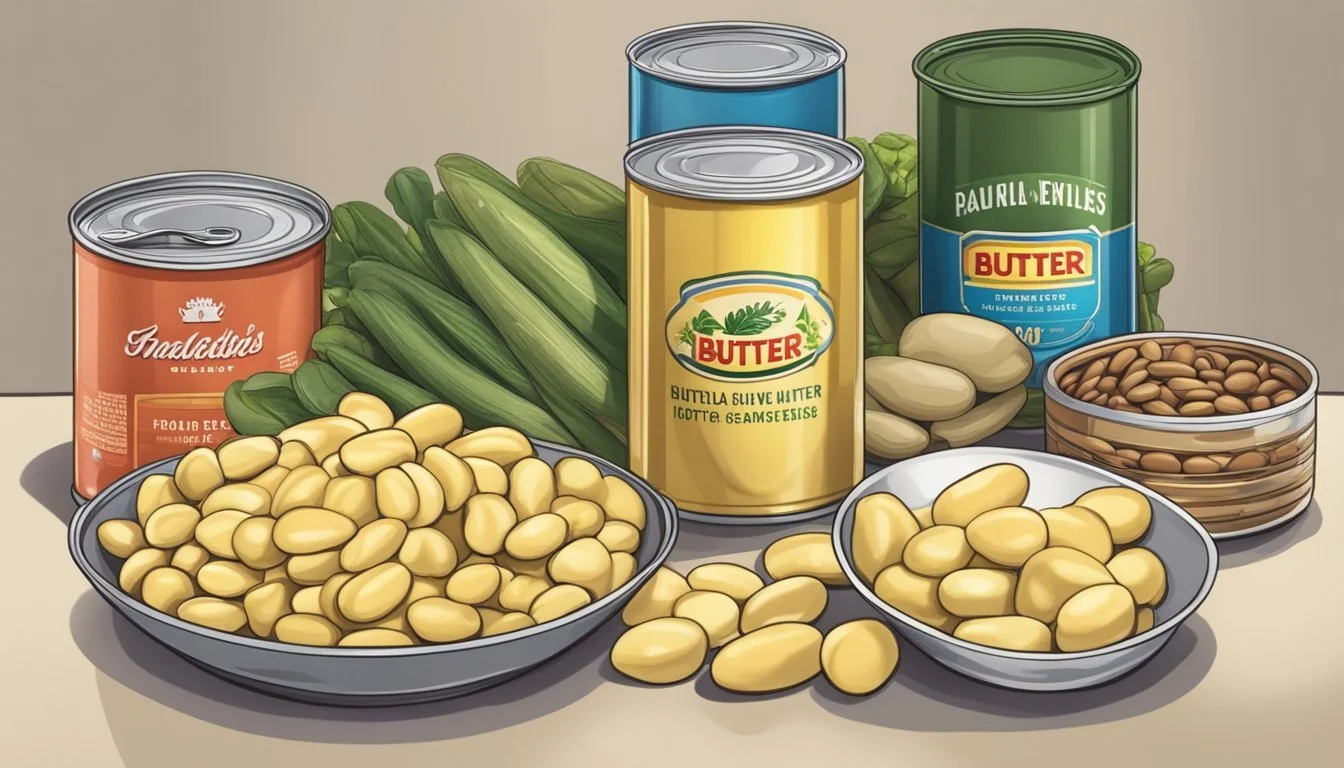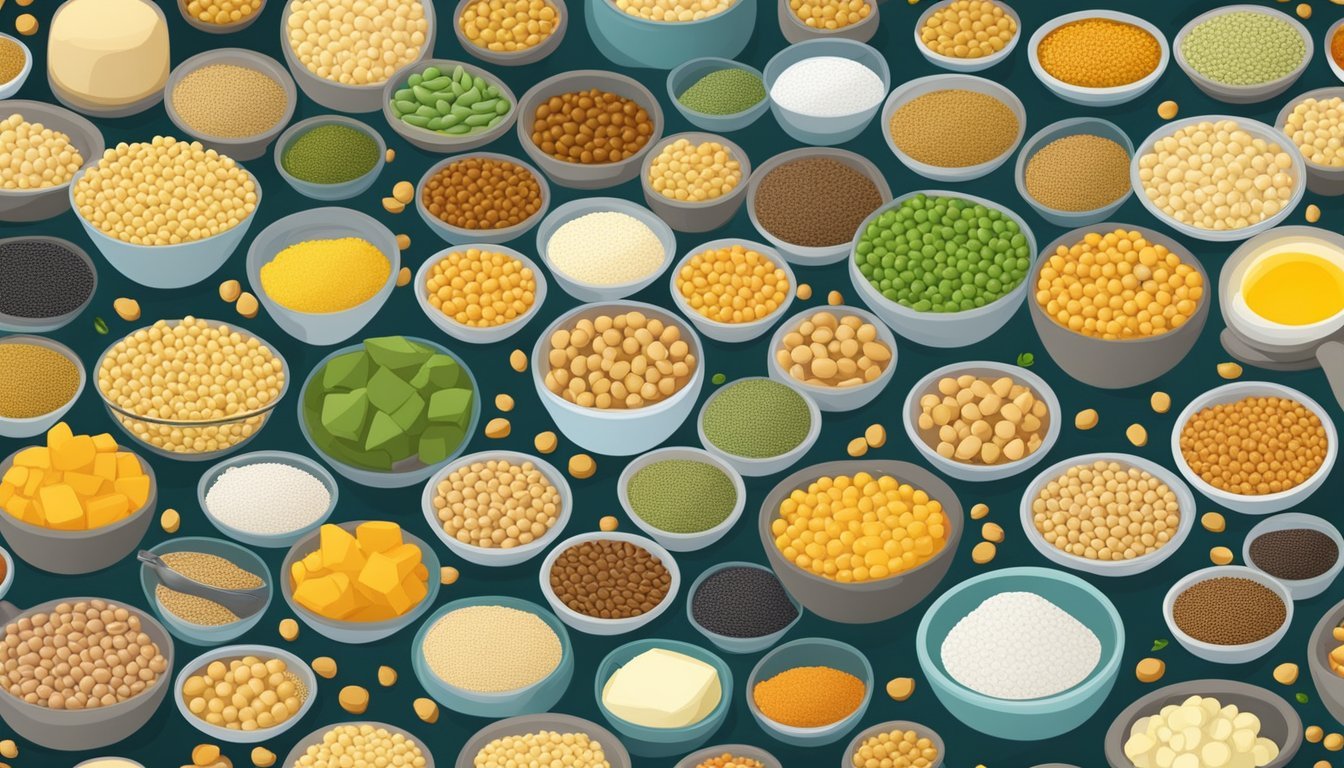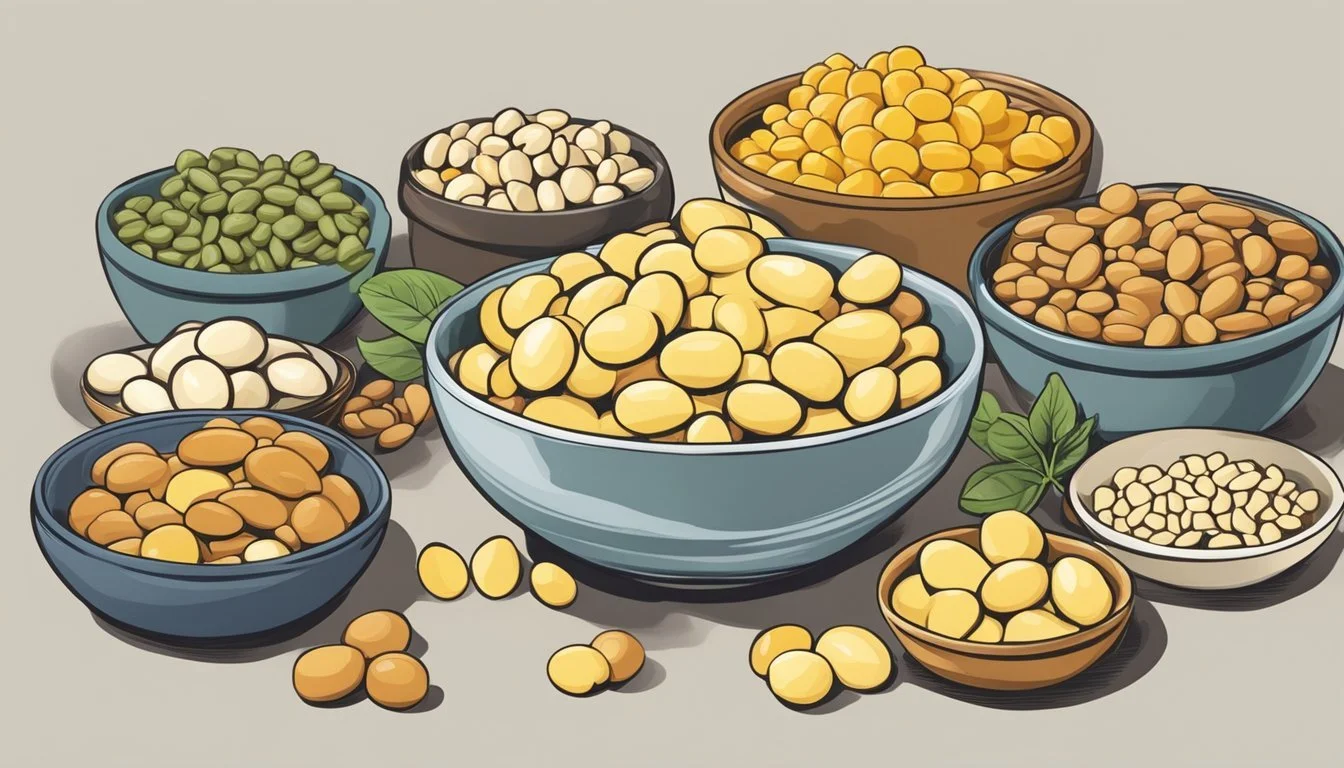Butter Beans Substitutes
Top Alternatives for Recipes
Butter beans, also known as lima beans, are a versatile legume celebrated for their creamy texture and mild flavor. They are a staple in many culinary creations, ranging from soups and stews to salads and casseroles. Yet, availability can sometimes be an issue, prompting cooks to seek suitable substitutes. Navy beans and cannellini beans stand out as excellent replacements, providing a similar creamy texture and mild flavor.
Nutrition-wise, these substitutes also pack a punch. Navy beans, with their small size and mild taste, offer a rich source of protein and fiber. Cannellini beans, on the other hand, add a slightly nutty flavor that can enhance many dishes. Other substitutes like pinto beans and chickpeas can bring unique twists in taste and texture while fulfilling the same nutritional needs.
In any recipe that calls for butter beans, these alternatives can seamlessly blend in, ensuring that the culinary intent and nutritional value remain intact. Whether crafting an Italian-inspired dish or a comforting stew, these substitutes can provide the right balance and flavor.
Understanding Butter Beans
Butter beans, also known as lima beans, have a smooth, creamy texture and a mild, slightly sweet flavor. They are highly nutritious and versatile in various culinary applications.
Characteristics of Butter Beans
Butter beans feature a pale, somewhat greenish color and a soft, buttery texture when cooked. Their mild flavor allows them to absorb the taste of other ingredients in a dish. As legumes, they are related to other beans but stand out due to their creamy consistency. When raw, butter beans have a tough skin that becomes tender after cooking.
Key Characteristics:
Appearance: Pale, sometimes slightly green
Texture: Creamy and smooth when cooked
Flavor Profile: Mild and slightly sweet
Nutritional Profile
Butter beans are packed with essential nutrients, making them a valuable addition to a balanced diet. They are rich in fiber, which aids in digestion and heart health. These legumes are also a good source of plant-based protein, providing a meat-alternative for vegetarians and vegans. Moreover, they contain significant amounts of iron, magnesium, and potassium, contributing to overall well-being.
Nutritional Highlights:
Fiber: Supports digestive health
Protein: Plant-based, essential for muscle repair
Iron: Vital for oxygen transport in blood
Magnesium: Important for muscle and nerve function
Potassium: Helps regulate fluid balance and nerve signals
Culinary Uses
In the kitchen, butter beans can be employed in various dishes due to their adaptable flavor and texture. They complement soups, stews, and casseroles, adding a creamy and hearty component. Their mild taste makes them suitable for salads, pairing well with herbs, spices, and other vegetables. Additionally, butter beans can be mashed or pureed as a base for dips and spreads or served as a wholesome side dish.
Common Culinary Applications:
Soups and Stews: Add creaminess and substance
Salads: Enhance texture and absorb flavors
Dips and Spreads: Can be mashed or pureed
Side Dish: Simply seasoned and served warm
Butter beans offer a versatile, nutritious option suitable for diverse culinary creations.
Choosing Substitutes
Selecting the best butter bean substitutes involves considering several factors such as texture, flavor, and nutritional value. Each substitute offers unique characteristics that can complement various recipes.
Texture Considerations in Substitutes
Texture plays a critical role in how well a substitute can mimic butter beans. Cannellini beans offer a creamy texture similar to butter beans, making them a suitable choice for soups and stews. Navy beans, also known as Boston beans, have a smooth, tender texture that can easily blend into casseroles and salads.
Chickpeas (Garbanzo beans) present a firmer texture, which may not be a perfect match for every dish but works well in recipes requiring added robustness. Each of these beans brings a different mouthfeel, so selecting the right one depends on the specific dish's texture requirements.
Flavor Profiles of Possible Substitutes
Flavor is another crucial factor when choosing butter bean substitutes. Butter beans have a mild and slightly buttery flavor. Cannellini beans offer a mild, slightly nutty taste that blends well without overpowering other ingredients.
Navy beans have a similarly mild flavor but with a hint of earthiness, making them versatile in various dishes. Chickpeas, with their nutty and somewhat earthy flavor, work well in more robust dishes like stews and chilis. Evaluating the flavor compatibility with your recipe is essential for a seamless substitution.
Nutritional Comparisons
Different substitutes bring varied nutritional benefits. Butter beans are rich in protein and dietary fiber. Cannellini beans provide similar nutritional benefits, being high in protein and low in fat.
Navy beans are also comparable, with a good balance of protein and carbohydrates, making them an excellent option for maintaining nutritional value. Chickpeas are high in protein and fiber, and they offer additional benefits like a significant amount of iron and other minerals. When choosing a substitute, consider the dietary needs and health goals associated with your recipe.
Types of Substitutes and Their Uses
Different beans can serve as substitutes for butter beans, each offering unique textures and flavors suitable for various culinary applications. Below, we explore specific types of substitute beans and how they can be effectively used.
Cannellini Beans and Their Usage
Cannellini beans, also known as white kidney beans, are an excellent substitute for butter beans due to their creamy texture and slightly nutty flavor. They work well in Italian dishes such as minestrone and can be used in soups, stews, and salads.
Their shape holds up well to cooking, making them ideal for recipes that require longer cooking times. Whether in a hearty casserole or a fresh bean salad, cannellini beans are both versatile and delicious.
Navy Beans in Different Recipes
Navy beans, also referred to as Boston beans, offer a small, creamy texture that mimics that of butter beans. They are often used in baked beans and are suitable for soups, stews, and even mashed applications.
These beans absorb flavors well, making them perfect for dishes such as navy bean soup or a bean and ham stew. Their mild taste allows them to blend seamlessly into various recipes, enhancing the overall dish without overpowering it.
Chickpeas as a Versatile Option
Chickpeas, also known as garbanzo beans, boast a firm texture and nutty flavor, making them a great substitute in many recipes. They are perfect for hummus, salads, and roasted snacks.
Chickpeas can be used in soups, curries, and casseroles, providing a different texture experience while maintaining the bulk needed in dishes. Their versatility extends to both savory and sweet applications, making them a staple in many kitchens.
Great Northern Beans for Mild Applications
Great Northern beans provide a mild flavor and smooth texture, suitable for recipes that require a subtler bean presence. They are great in soups, stews, and casseroles, offering a delicate taste that complements various ingredients.
These beans are ideal for dishes requiring a longer simmering time, ensuring they absorb the flavors of the other components while maintaining their integrity.
More Alternatives for Diverse Flavors
Other excellent substitutes include borlotti beans, black beans, pinto beans, and fava beans. Borlotti beans add a rich, nutty flavor, perfect for stews and casseroles. Black beans provide a dense, slightly sweet taste, ideal for Latin dishes like beans and rice or burritos.
Pinto beans work well in chili and refried bean recipes, while fava beans offer a firm texture suited for Mediterranean dishes. Each of these options brings its own unique flavor and texture to a recipe, making them worthwhile choices as butter bean substitutes.
Substituting Butter Beans in Specific Dishes
When replacing butter beans in recipes, it’s important to consider the texture, flavor, and cooking requirements of different beans. Various dishes like soups, salads, dips, and pasta can benefit from thoughtful substitutions to maintain their intended characteristics.
Beans for Soups and Stews
In heartwarming soups and robust stews, cannellini beans or navy beans work well to replace butter beans. These beans offer a creamy texture and the ability to absorb surrounding flavors, making them ideal for minestrone soup and hearty chilis.
Navy beans, also known as Boston beans, blend seamlessly into stews, delivering a satisfyingly smooth mouthfeel. Cannellini beans, with their slightly nutty and earthy flavors, can add depth to dishes without overpowering other ingredients.
Best Beans for Salads
For a satisfying salad, pinto beans and black-eyed peas are excellent alternatives to butter beans. These beans maintain their shape well and provide a pleasant, firm texture that compliments mixed greens and three-bean salads.
Pinto beans bring a subtly sweet flavor, making them perfect for cold salads and pasta-based side dishes. Black-eyed peas stand out with their earthy taste and are often used in Southern-style salads, adding a unique twist to traditional recipes.
Legumes in Dips and Spreads
Creating flavorful dips and spreads without butter beans is effortlessly achieved with chickpeas and borlotti beans. Chickpeas are known for their firm texture and nutty flavor, essential in hummus and other mashed bean spreads.
Borlotti beans, on the other hand, offer a creamy consistency with a slight earthy undertone. They add richness to spreads while blending smoothly with garlic, olive oil, and herbs, making them a versatile choice for various spread recipes.
Alternative Beans in Pasta and Risotto
In dishes like pasta and risotto, the substitute has to mirror the creamy and slightly sweet characteristics of butter beans. White kidney beans, or cannellini beans, can be used to uphold these qualities.
Their mellow flavor integrates well into pasta sauces and risotto, providing a uniform texture. They help maintain the creaminess of risotto dishes without altering the fundamental taste profile, making them a reliable alternative in Italian cuisine.
Special Considerations in Substitution
Choosing substitutes for butter beans involves careful consideration of factors such as health benefits, cooking times, flavor and texture balance, and availability. These elements ensure that the substitute chosen is both nutritious and practical for the intended recipe.
Impact on Health Benefits
Substituting butter beans with other legumes requires understanding the nutritional profiles.
For instance, chickpeas offer a nutty flavor and firm texture, rich in protein and fiber, promoting a healthy digestive system.
Cannellini beans, common in Italian cuisine, provide a creamy texture with significant amounts of iron and fiber.
In South America, black beans are valued for their high antioxidant content and have a creamy texture, enhancing cardiovascular health.
Ensuring substitutes match or exceed the health benefits of butter beans is crucial.
Adjustments for Cooking Times
Different legumes require varying cooking times.
Navy beans or Boston beans cook relatively quickly, making them convenient for soups and stews.
Chickpeas, however, need longer cooking times unless pre-cooked or canned variants are used.
Black beans can also take a substantial time to soften, especially if dried.
Adjusting cooking methods or using pre-cooked options ensures the substitute fits seamlessly into the recipe. Monitoring cooking to achieve the desired texture, whether smooth or firm, is essential.
Balancing Flavors and Textures
Maintaining the dish’s integrity requires balancing flavors and textures when substituting.
Pinto beans have a mild flavor and smooth texture, suitable for three-bean salads and minestrone.
Soybeans deliver a firm texture and a mild, slightly sweet flavor, suitable for East Asian dishes.
Great Northern beans offer a delicate flavor and creamy texture, effective in stews and casseroles.
Matching the flavor profile and texture of butter beans ensures the substitute enhances the dish without overpowering it.
Availability of Substitutes
The availability of substitutes varies by region.
Cannellini beans are readily available in Italy and some parts of Europe.
In South America, black-eyed peas and borlotti beans are common substitutes.
North America often stocks navy beans and pinto beans.
Quinoa, though not a bean, can also serve as a protein-rich alternative and is globally available.
Understanding regional availability helps choose a substitute that is both accessible and suitable for the dish, ensuring practicality in culinary applications.
Global Ingredients as Butter Bean Substitutes
Exploring global ingredients offers diverse and nutritious options for replacing butter beans in various dishes. Each substitute brings its unique flavor, texture, and nutritional benefits, making them effective alternatives.
Asian Varieties: Edamame and Soybeans
Edamame and Soybeans are popular in East Asian cuisine. Edamame beans are immature soybeans, typically boiled or steamed and served in their pods. These beans boast a high protein content and are rich in vitamins and minerals.
In cooking, edamame can replace butter beans in salads, rice bowls, and soups. Soybeans, on the other hand, can be used in stews and casseroles. They're versatile and provide a creamy texture similar to butter beans. Both options are excellent sources of dietary fiber and iron.
South American Specialties: Quinoa and Black-Eyed Peas
Quinoa and Black-Eyed Peas originate from South America and provide a nutritious alternative to butter beans. Quinoa is a seed, not a bean, but it has a similar texture when cooked. It is rich in protein, fiber, iron, and essential amino acids.
Quinoa can be used in salads, soups, and as a side dish. Black-Eyed Peas, known for their slightly earthy flavor, are also nutrient-dense, offering fiber, protein, and several minerals. They work well in soups, stews, and casseroles, providing a satisfying substitute for butter beans.
Mediterranean Picks: Garbanzo Beans and Lentils
Garbanzo Beans (Chickpeas) and Lentils are staples in Mediterranean diets. Chickpeas have a nutty flavor and firm texture, making them great in stews, salads, and casseroles. They are high in protein, vitamins, and minerals.
Lentils come in various colors and sizes, each with distinct flavors and textures. Green and brown lentils are firm when cooked, suitable for salads and soups, while red lentils become soft and creamy, perfect for curries and stews. Both garbanzo beans and lentils are rich in fiber and iron, making them valuable substitutes for butter beans.
Additional Ingredients to Enhance Substitute Beans
Using substitute beans can be improved by incorporating herbs, spices, aromatics, complementary vegetables, and grains to elevate the dish's flavor and texture.
Herbs, Spices, and Aromatics
Adding herbs, spices, and aromatics can transform the taste profile of substitute beans. Onion and garlic are foundational, providing depth and richness when sautéed. Incorporating thyme, rosemary, and bay leaves can lend complexity, while cumin and paprika bring warmth and earthiness. Additionally, a splash of soy sauce or a pinch of red pepper flakes can boost umami and add a subtle kick to the dish.
Combining Beans with Vegetables
Pairing substitute beans with certain vegetables can enhance both flavor and texture. An excellent combination includes beans with bell peppers, zucchini, or spinach, which add freshness and nutritional value. Carrots and celery contribute a crunch that contrasts nicely with the creaminess of beans. Adding sautéed mushrooms imparts umami, making the dish heartier. Tomatoes, whether diced or in a sauce, can provide a tangy counterpoint that brightens the overall flavor.
Using Grains for Texture and Flavor
Grains can significantly enhance the texture and flavor of dishes with substitute beans. Incorporating quinoa adds a nutty taste and a slightly crunchy texture, making the dish more satisfying. Barley offers a chewy texture, while farro provides a robust, nutty flavor that complements the creaminess of beans. Serving the beans with a side of brown rice can add a wholesome, earthy component. For a twist, topping the bean dish with a sprinkle of crispy fried onions or grated cheese can introduce an additional layer of flavor and texture.




